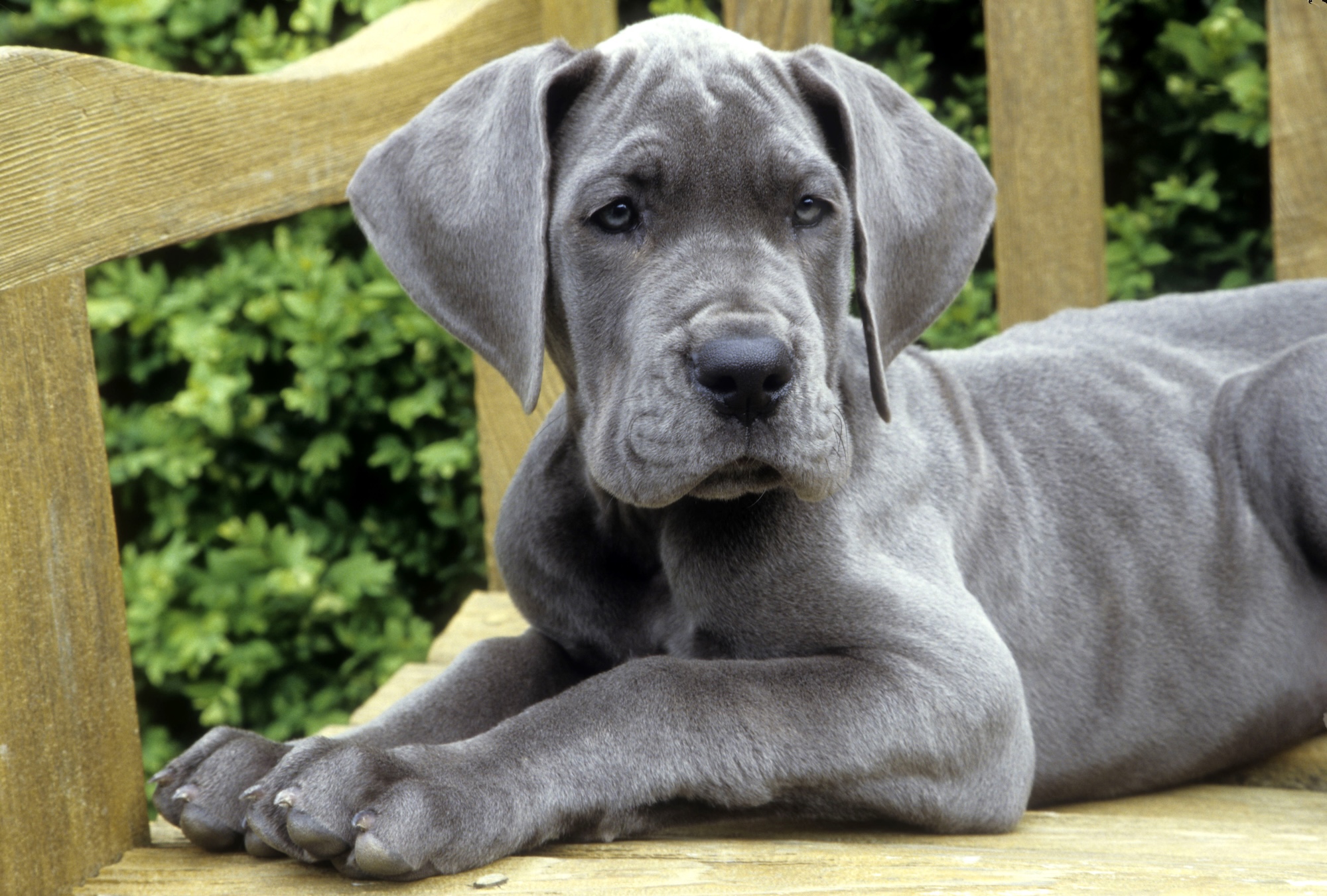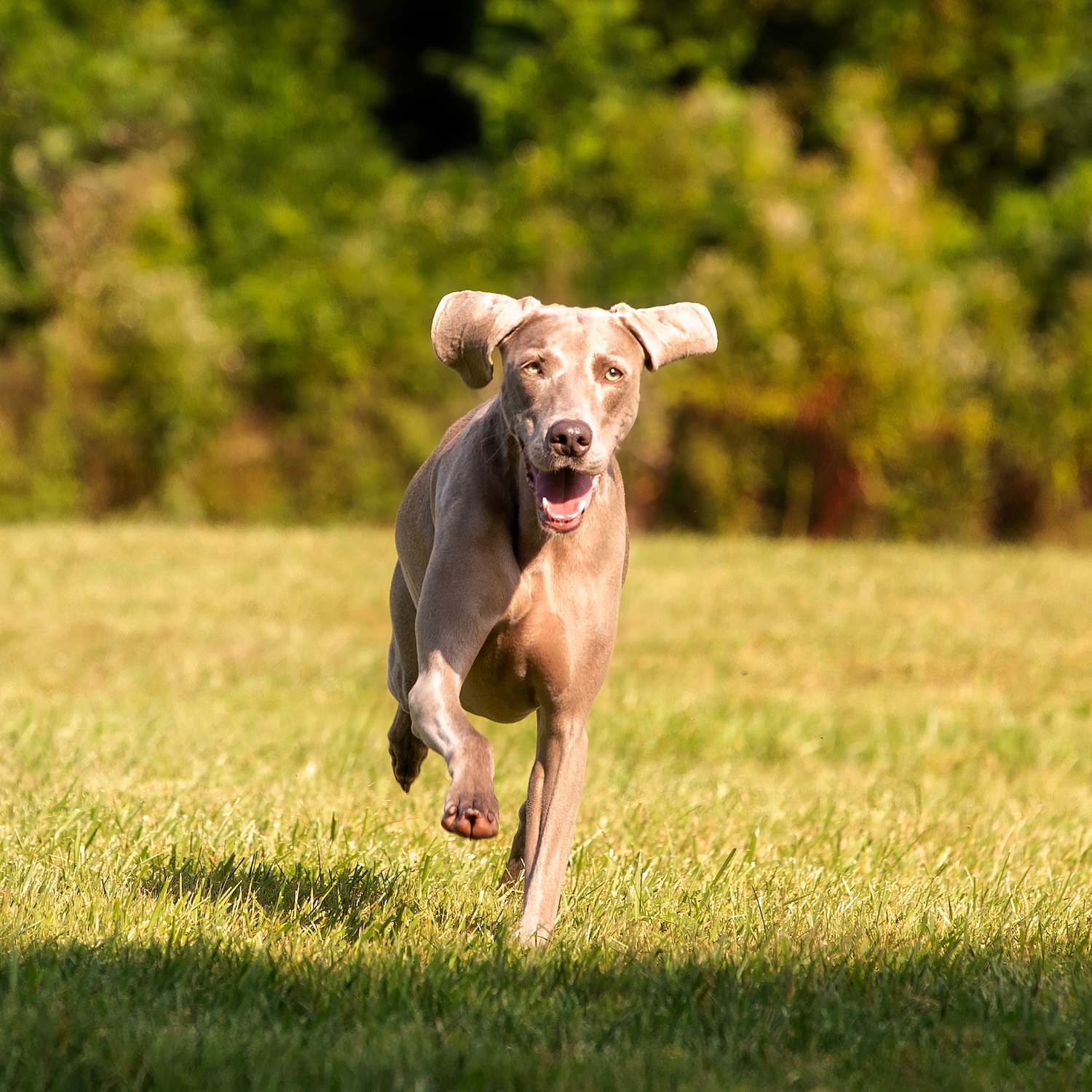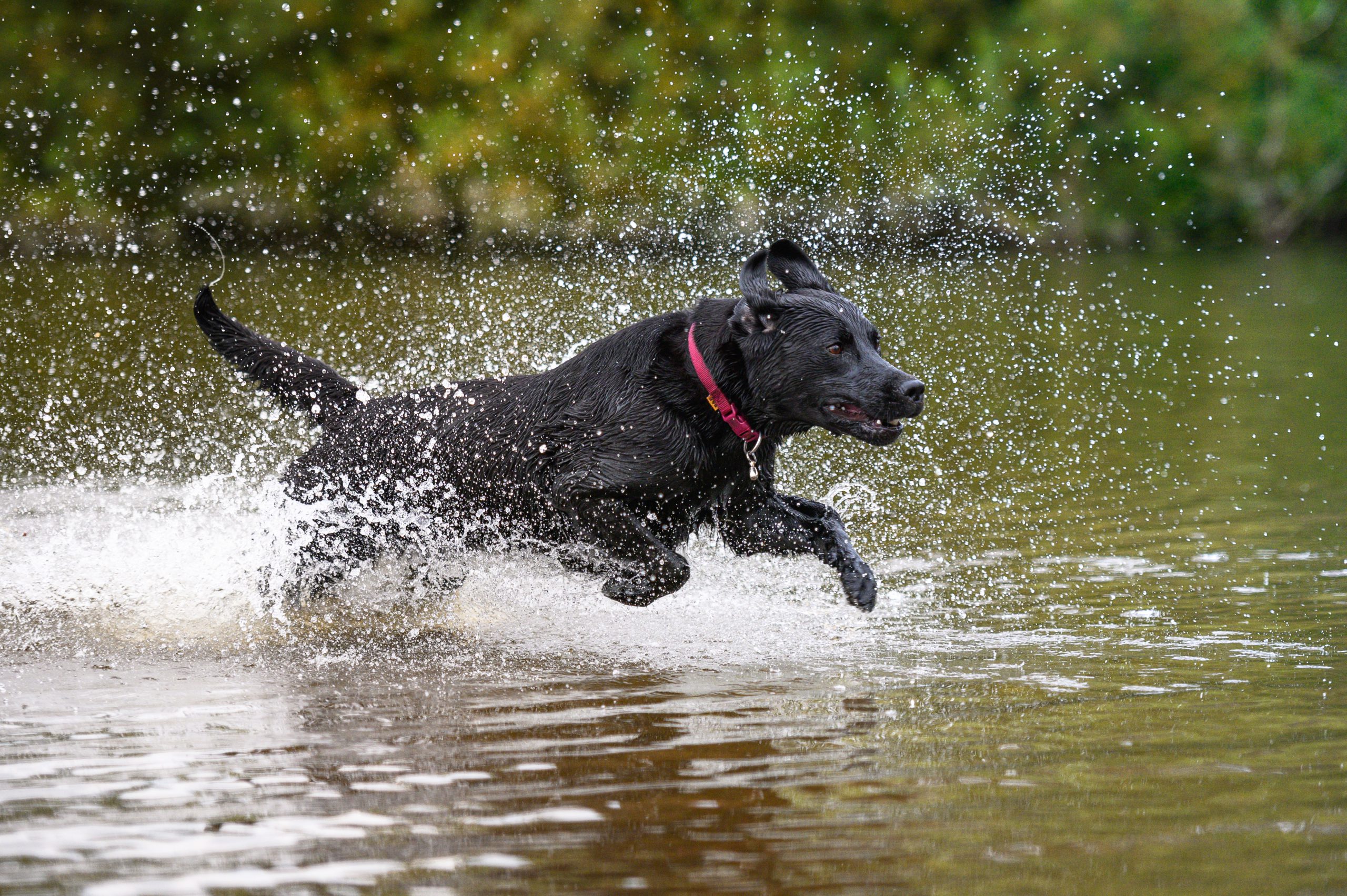There’s a lot to know and understand about the dogs who fall into the category of “pit bull.” Here, we explore what it means to be, and own, a pit bull, and how to look after this most people-oriented, yet polarizing pet.
[lwptoc title=”The Pit Bull Guide” width=”75%” colorScheme=”inherit” backgroundColor=”” borderColor=”#000000″ linkColor=”#000000″]
What is a pit bull, exactly? It’s complicated
Identifying a pit bull is just the first complicated part of our relationship with these dogs. Unlike Labrador retrievers and dachshunds, pit bulls aren’t considered a distinct dog breed by the American Kennel Club, the largest and most influential U.S. breed registry. The American pit bull terrier, whose appearance many non-breeders would identify with the “pit bull” breed, is recognized by the United Kennel Club, and by the American Dog Breeders Association.
Other dog breeds officially recognized by various breed registries may also be identified by ordinary people as pit bulls. The rescue, adoption, and advocacy organization Love-A-Bull points out that these include the American Staffordshire terrier, the Staffordshire bull terrier, and mixes of these breeds. The American bully is also frequently classified as a pit bull. Some people may even include the Bull terrier and the American bulldog in this category.
Other dogs end up falling under the pit bull umbrella because of some of their physical characteristics—they’re often stocky, with wide mouths, square-ish heads, and short, smooth coats. They vary in size but tend to fall between 30 and 85 pounds. But even taken together, these traits are not unique to pit bulls. So, “pit bull” is really a loose term that can refer to dogs of various sizes, shapes, and genetic mixtures.
In the end, more than a breed, pit bull is an idea, and there are few more powerful, or polarizing, canine ideas.
Note: Just like humans, all dogs are individuals, with unique genetics, life experiences and environments that influence their behavior. Be sensitive to what your specific companion is telling you about their needs, beyond what you may expect given the breed.
Breed history of pit bulls
Most dogs commonly identified as pit bulls originated in the United Kingdom when breeders were looking to combine “the gameness of the terrier with the strength and athleticism of the bulldog,” according to the United Kennel Club. The Olde English bulldog (which looked similar to the modern American bulldog) was used in the cruel but popular sport of bull-baiting, in which dogs were directed to attack a chained bull or bear.
This sport put a premium on certain traits: muscularity, strong jaws, and being compact and close to the ground. After the British Parliament banned the baiting of bulls and bears in 1835, other cruel sports involving dogs developed in their place, pitting dogs against rats and then other dogs. These sports required greater speed and agility than baiting, so Olde English bulldogs were crossed with terriers.
All of these sports required humans to be able to handle the dogs safely, so while aggression toward other animals may have been a trait selected for by breeders and instilled through training, aggression toward humans would often cause a dog to be killed.
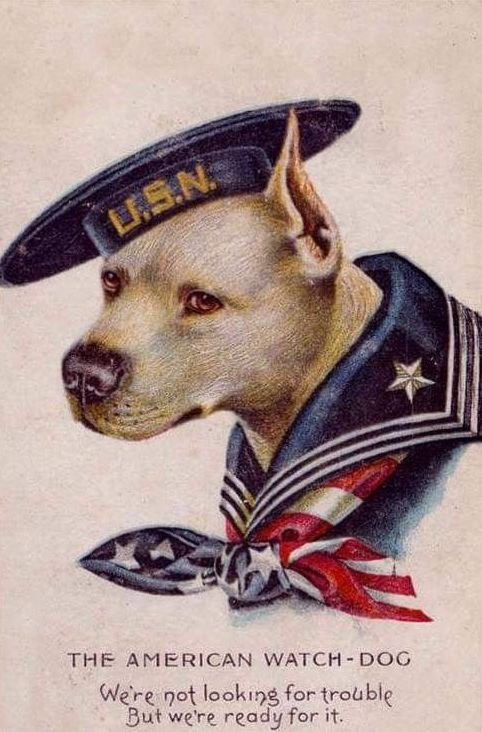 British immigrants brought pit bulls to the U.S., where they were seen as dogs of the working class, and then, dogs for everyone. Pit bulls occupied the role of “regular” dog for many years. In fact, for a long time, the pit bull was both a particularly popular family dog and something of an American canine hero. Pit bulls became a U.S. military mascot during WWI and feature prominently on propaganda posters from that era. In one Navy poster, a white dog with a jaunty cap appears above the caption, “We’re not looking for trouble, but we’re ready for it.” A pit bull named Sergeant Stubby, who delivered messages during the war, was decorated for bravery.
British immigrants brought pit bulls to the U.S., where they were seen as dogs of the working class, and then, dogs for everyone. Pit bulls occupied the role of “regular” dog for many years. In fact, for a long time, the pit bull was both a particularly popular family dog and something of an American canine hero. Pit bulls became a U.S. military mascot during WWI and feature prominently on propaganda posters from that era. In one Navy poster, a white dog with a jaunty cap appears above the caption, “We’re not looking for trouble, but we’re ready for it.” A pit bull named Sergeant Stubby, who delivered messages during the war, was decorated for bravery. Pit bulls were a fixture in homes, and as babysitters (though, contrary to lore, the term “nanny dogs” wasn’t actually used until the 1970s, according to Bronwen Dickey, author of Pit Bull: The Battle Over an American Icon, who also points out that no dog should be left alone with a baby). A pit bull named Tige was the sidekick in a popular comic, Buster Brown, and then came Petey, who became famous across generations as the Little Rascals’ mascot on the TV show Our Gang. Pit bulls were America’s dog. And in a much more complicated way, they still are.
The pit bull and us
The other breed profiles on this site examine the individual’s relationship with the dog in question. For the pit bull, there’s a whole other relationship to consider—our society’s relationship with, and perception of them.
As Esquire writer Tom Junod wrote, “There is no other dog that figures as often in the national narrative—no other dog as vilified on the evening news, no other dog as defended on television programs, no other dog as mythologized by both its enemies and its advocates, no other dog as discriminated against, no other dog as wantonly bred, no other dog as frequently abused, no other dog as promiscuously abandoned, no other dog as likely to end up in an animal shelter, no other dog as likely to be rescued, no other dog as likely to be killed.” It’s a lot of weight to bear for a dog that’s never as big as its reputation. And that reputation has long been linked to fighting.
Dog fighting was banned in the U.S. in the 1970s and is a felony in all 50 states. But the practice stayed with us, with people continuing to breed pit bulls for fighting and protection (even though many more people were breeding pit bulls and their related breeds for companionship, selecting the other natural qualities the dogs had long exhibited—affection, loyalty, and gentleness). Media attention to the dogfighting phenomenon in the 1980s helped shape the breed’s negative reputation.
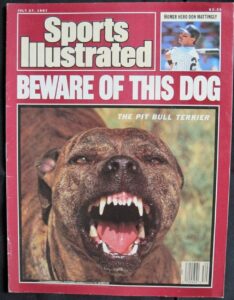
Landlords and cities outlawed the dogs, with breed-specific legislation starting to crop up in cities across the country in the early 80s. The pit bull’s “tough” look and brave, irrepressible nature which made it such an apt mascot for America during the war, became the breed’s biggest liability.
Despite ample research, though, there’s nothing to suggest that pit bulls are more innately aggressive than other breeds, regardless of which breeds you lump under the pit bull banner. A 2017 study from the American Temperament Test Society, which tests breeds for aggressiveness, found that both the American pit bull terrier and the American Staffordshire bull terrier are among the most tolerant dog breeds, less prone to aggression than breeds like the fearsome chihuahua, the mighty Pomeranian, or the dread toy poodle (None of those breeds are particularly aggressive, though, which proves something most of us understand intuitively: all dogs are inherently good dogs).
A pit bull’s jaws don’t lock (“there is no such thing as ‘jaw locking’ in any breed,” Cornell University veterinary professor Howard Evans told the Pit Bull Rescue Center). Their bite pressure, while strong, is generally considered less than that of a German shepherd or a Rottweiler (although many of the scary “pounds per square inch” numbers that are bandied about in articles have no basis in science, as measuring bite pressure is really complicated).
The fighting reputation is something that every pit bull owner has had to deal with, and it’s also one that feeds into itself. According to Nelson Hodges, trainer and head of the Canine Human Relationship Institute, the idea that pits are aggressive leads people who want an aggressive dog to seek them out. “They’ve been abused—not just misused, but abused—by people for a long time,” Hodges says. “I’ve worked with some of the sweetest pit bulls. Unfortunately, humans see them a certain way, and use them that way.”
As they are used, they are also discarded. Pit bulls of all types are still bred in huge numbers which, together with many other factors, means that pit bulls outnumber other breeds in shelters. The ASPCA estimates that of the 3.3 million dogs in shelters each year, 670,000 are euthanized; many estimates indicate that about 40% of those dogs are pit bulls, though taking stock of their numbers relies on the inexact science of actually identifying them as pit bulls. And that’s another complicating factor—pit bulls tend to be whatever we say they are when it comes to counting dogs in shelters, or counting dog bites. A 2016 study backed by Maddie’s Fund showed that even shelter employees (who can be considered subject matter experts) can’t reliably identify a “true” pit bull. Only 36% of the dogs identified as pit bulls by shelter staff were actually pit bulls by DNA analysis, and staffers missed 20% of the true pit bulls. Previous studies have similarly found that experts have low rates of agreement in their visual assessment of dog breed.
Research also shows that whether or not a dog is actually a pit bull, the assumptions that come with labels are real, and can have grave repercussions for many dogs. A 2016 study from Arizona State University found that dogs labeled as pit bulls stayed in shelters three times longer than “phenotypically similar” (lookalike) dogs labeled as another breed. The study also found that when breed labels were removed from the adoption process, pit bulls were more likely to be adopted —and in fact, so were other breeds. In this, and in other areas, pit bulls make a compelling argument for letting go of a strict concept of “breeds.”
 The Michael Vick dogfighting and abuse case represented a turning point for pit bulls, demonstrating to the public that fighting dogs were horrifically abused but could be rehabilitated. As the Best Friends Animal Society notes, since their rescue, many of the dogs earned their Canine Good Citizen certificate and became adored pets or service dogs, and their stories prove that “no dog is inherently vicious, no matter her breed or background.”
The Michael Vick dogfighting and abuse case represented a turning point for pit bulls, demonstrating to the public that fighting dogs were horrifically abused but could be rehabilitated. As the Best Friends Animal Society notes, since their rescue, many of the dogs earned their Canine Good Citizen certificate and became adored pets or service dogs, and their stories prove that “no dog is inherently vicious, no matter her breed or background.”Along with many abused dogs, the breed’s reputation is being rehabilitated as pit bulls are increasingly seen as being unfairly targeted by human abuse and prejudice. There are still breed bans in hundreds of U.S. cities, but there’s more and more evidence that shows the bans are ineffective, and that pit bulls in themselves were never the real problem. Every major public health and animal health organization (including the American Kennel Club, the American Veterinary Medical Association, the Centers for Disease Control and Prevention, The National Canine Research Council, HUD, and the American Bar Association) has concluded that “BSL and similar policies that restrict dogs based on appearance do not reduce dog bites in communities or enhance public safety.”
Pit bulls are gaining visibility as therapy dogs, a task their people-pleasing nature makes them well-suited to, as narcotics detection dogs, and as just good dogs.
Living with a pit bull
The pit bull personality
Every dog is different. This includes pit bulls as many are a mix of different types of dogs. Like people, their personalities as individuals are shaped by genetics, life experiences, and the people around them.
Many owners agree, though, that pit bulls are people-oriented, affectionate, and playful. While they’ll adapt their energy levels to their living situation, they’re athletic dogs who do well with ample daily exercise and mental stimulation, and a close eye on diet to avoid weight gain.
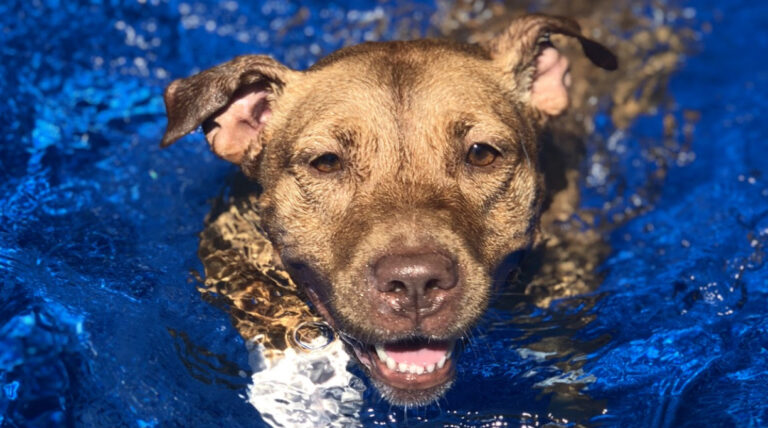
Rosie in her element
Pit bull loves: People and food…
The pit bull owners we consulted describe their dogs as “very loyal and attuned to their humans.” Kimberly Tom* describes her dog Dusty (DNA tested and 100% ABPT) using the scientific term: “cuddle monster.” He’s also “very eager to please,” she says. “He cares very much about what we want him to do, with strong listening skills with commands, and very immediate reaction to praise and assertive tone.”
Paige McGregor, owner of Rosie says her dog is “obsessed with cuddling anyone and everyone who will allow her to, with special attention to newbies” (McGregor also notes that Rosie “believes she’s a fish (refer to photo above) and loves to yell into her yawns to make sure everyone knows she’s tired OR awake”).
Kimberly Tom and pit bull owners Kendra Prasad and Rachel Chen note that the owner-attuned attitude extends to energy levels. “They are down for whatever I’m in the mood for—naps, hikes, snuggles on the couch,” says Prasad of her dogs Remi and Mo. Says Chen, of her pit bull, Ross, “he can sleep all day or go on long hikes.”
Pit bull owners also tend to agree that their dogs are food motivated. “Extremely. I repeat.. EXTREMELY food-driven,” says Tom. “Loves every single food item and gives iceberg lettuce a 10/10.” McGregor says, “if there was only one word in Rosie’s language it would be ‘treat.’”
…And chewing
While they don’t have any sort of unique locking jaw, pit bulls tend to be powerful chewers.
“He’s just strong in general but particularly his jaws,” says Tom. “He loves to chew his Nyla bones especially when he’s excited to channel his energy. He had an elk antler a few years ago and since they’re denser than teeth and he’s such a powerful chewer, he broke his tooth and had to get surgery.” Prasad says: “I have to take toys away from Remi sometimes because she will chew and rip until she’s bleeding and still won’t want to stop.”
Pit bull mix (and Chiefs fan), Miller
About other dogs
Pit bulls have retained a reputation for antipathy toward other dogs, and some owners and experts will attest that pit bulls, as a generalization, are not oriented to other dogs. They are people-pleasers. But this can come down to previous experience and socialization and doesn’t mean all pit bulls are innately dog-aggressive. “Dusty is not good with other dogs,” says Tom. “We don’t know much about his past but we don’t think his interactions with dogs in his early years were positive interactions.”
There are others, like Chen who say their dogs are fine with their own kind. Ross is “docile and good with other dogs,” says Chen.
Jason Flatt, who runs pit bull rescue operation Friends to the Forlorn, and has rescued thousands of pit bulls and lives with a house full of the dogs, puts it simply: “When a pit bull is dog-aggressive, I’m not surprised. If he’s not, it’s a bonus.” And, as Flatt emphasizes, dog aggression does not translate to human aggression.
You shouldn’t expect to get a pit bull and immediately turn them loose in a dog run. But then again, many experts, including Flatt, say for any dog, a dog run is not an ideal environment, as not all owners are monitoring their dogs closely which creates ample opportunity for conflict.
Training and exercise
While pit bulls are full of affection, it’s important to remember their strength and determination. As Hodges puts it, they pack the tenacity of a terrier into a body that’s bigger, stronger, and heavier than a Jack Russell or a fox terrier. Because of their size and strength, early socialization is important along with intensive training for puppies, and ongoing adult training. As Friends to the Forlorn advises: “while the pit bull is an excellent companion, they are not right for everyone. They need a confident, decisive leader that will give them consistent structure and boundaries.”
The couch-friendly attitude, and food motivation mean that pit bulls require significant daily exercise, ideally with companions undaunted by their strength during playtime (small children, other animals, and people not up for vigorous play may find their strength too overwhelming, depending on the specific dog). Lots of brisk walking is called for. Games of tug can be a great energy burner, and give dogs something to sink their teeth into. But be sure to play tug on YOUR terms. Say when the game begins, and ends, and reward for good manners.
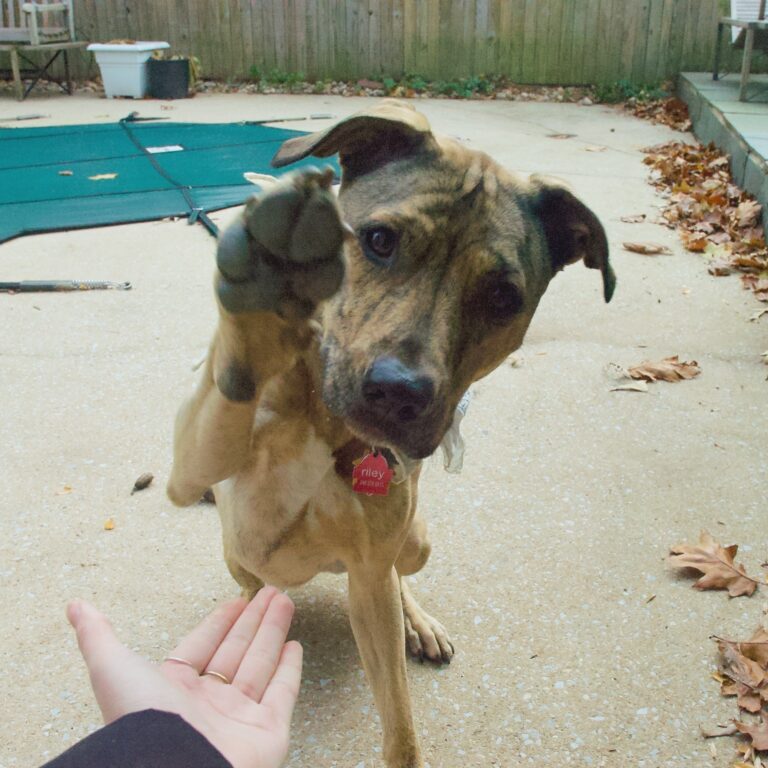
Riley the pit bull mix
Fending off separation anxiety, and “bullying” behavior
Because their people-centric nature can predispose these dogs to separation anxiety, it’s important to establish boundaries and give yourself, and your dog, space.
“Pit bulls tend to be very affectionate in a rather lovingly yet invasively bully-ish manner,” says Blake Rodriguez, trainer and founder of Dream Come True K9 in New York. “During these times it’s important to be mindful of the state of mind or physical behaviors that you allow. Teaching a dog a softer, more polite way to do these things will pay off big time when that type of behavior is more desirable.”
For example, he says, think of times when your dog’s good behavior is especially important, and when it’s more likely they’ll be excited—like around children or when there are guests present and food being served. “The way that you allow your dog to greet, relax, and behave around you, is likely what you can expect your dog to do, only in a more amplified manner in those other situations.” So be sure to take time practicing the behavior that you want. “Work in a more routine manner throughout the day where you are suggesting and allowing the behaviors and mindset you want, and that will set your dog up to be successful later,” says Rodriguez.
In summary, he says, “You’re going to get what you routinely allow.”
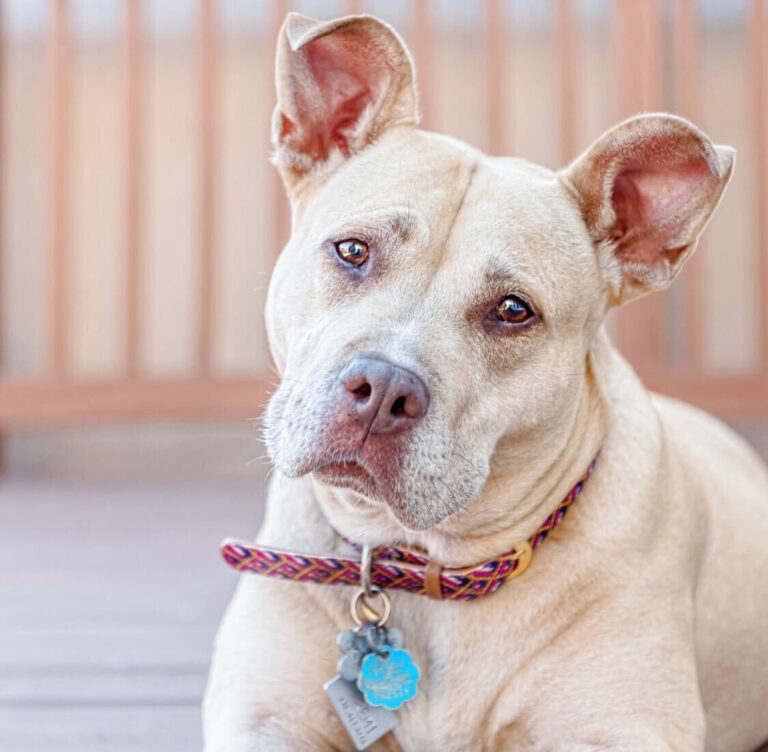
Remi is listening
Along with physical strength, managing the strength of perception
McGregor says that the personality of her dog Rosie has left her “obsessed with trying to change the negative public perception of them.”
This comes with a responsibility to know your dog, know how to read a dog’s body language, and stay clear of any situation in which you don’t have confidence and control. “Once I adopted Dusty, I was met with skepticism and assumptions that I did not expect,” says Kimberly Tom. “To me, he’s just my sweet new dog. So my piece of advice to other people and prospective pit bull adopters is to understand the stereotype and do everything you can to reverse it. Never put your dog (or any breed) in situations that set them up for failure. In these situations where a dog acts out, if it’s a pit bull, it feeds into everyone’s misconception. The misconception is a great media piece to play off of and the circle continues to repeat itself.”
Again, ongoing training is wise both to ensure good behavior and allay human fears.
Dogs rescued from serious abuse or neglect may have special sensitivities and needs, which an adoption organization can help identify to ensure a good match with your home and lifestyle.
Since breed-specific legislation is still in effect in some cities, check for any local laws regarding the breed.
Ross enjoys the outdoors
Breed-specific health concerns
Because pit bulls encompass a lot of dog diversity, it’s hard to pin down specific genetic health vulnerabilities. And many pit bulls live long, healthy lives without diseases. But the following health issues are thought to have a genetic risk factor in American pit bull terriers, bull terriers, and/or American Staffordshire Terriers unless otherwise mentioned – so if your pup is a pit bull type of any sort, these conditions are worth looking out for:
- Hip & elbow dysplasia: This joint health condition occurs when the joint is malformed. Over time, chronic pain and inflammation (arthritis) can develop. Large breed dogs are more likely to suffer from elbow and hip dysplasia. Keeping your dog lean, and on a high-quality diet is key in staving off, and managing arthritis. Glucosamine and chondroitin supplements (which also help many human arthritis sufferers!) can also help. Always be sure to discuss dietary supplementation with your vet.
- Patellar luxation: This is when a dog’s kneecap slips out of its proper place. Usually, this is temporary—the dog will limp briefly before their kneecap pops back into place. For severe and chronic patellar luxation problems, treatment ranges from arthritis medication to surgery.
- Hypothyroidism: This is a hormone insufficiency whose symptoms can include dry and itchy skin and coat, fur loss, other skin problems, and a negative change in behavior (fearfulness, aggression, etc.). Medication is used to treat this.
- Allergies: If your pup’s feet, belly, ears, or other skin folds are bothering them—causing a lot of licking or face rubbing behavior—or if they often get ear infections, it could be due to allergies.
- Ichthyosis: This is a severe, inherited skin condition causing itchiness and flaking. Puppies are usually affected from birth. The symptoms can be treated but there isn’t a cure.
- Neuronal Ceroid Lipofuscinosis, or NCL: This is a progressive neurological disease. Early symptoms include rear leg weakness and loss of balance in young adult dogs.
- Bladder and kidney stones: High uric acid in a dog’s urine, called hyperuricosuria, can cause bladder and kidney stones that require surgery. If a dog tests positive for hyperuricosuria, the risk of stones can be reduced through diet.
- Parvo susceptibility: Several dog breeds don’t respond as well as others to vaccination for parvo, a virus that can cause a fatal infection in puppies and make adult dogs fall ill as well. For this reason, pit bulls may require more frequent booster shots to protect them against parvo.
- Cleft lip or palate: Severe cases may require surgery in puppyhood to correct.
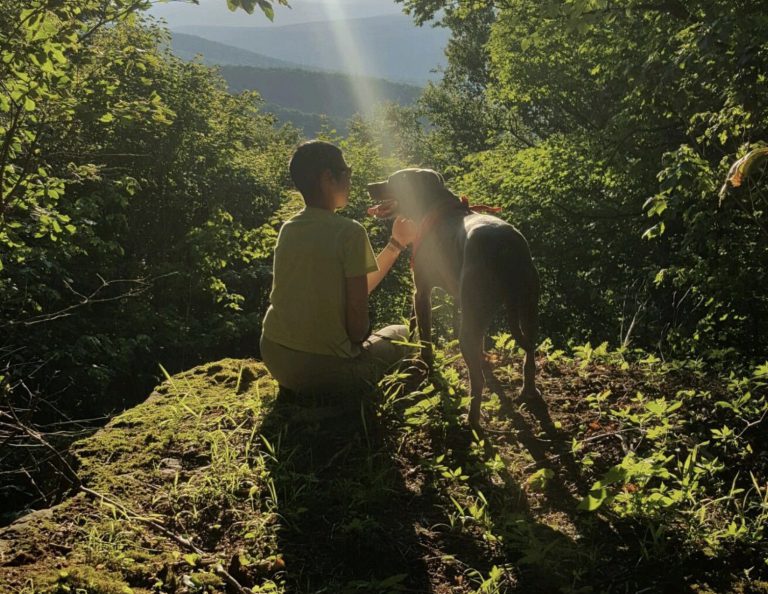
Kimberly Tom and Dusty
Feeding a pit bull
There are some fundamental best practices for feeding your pit bull that will help them maintain a healthy weight, reduce digestion problems, and ensure routine meal consumption at scheduled times.
- Avoid sharing food from the table with your pup. Even though many “human” foods are fine for dogs to eat, some aren’t, and they can be the source of digestive distress that can be unpleasant for both of you. Sharing your food with your pet can make it hard to ensure correct nutrient ratios and calories per day, and can encourage unwelcome intrusions on your own mealtime.
- Many pit bulls are food fanatics. Keep treats special, and useful as training incentives, by not overfeeding them. Keep extras to no more than 10% of daily calories, and lean to single-ingredient options like veggies and the occasional fruit. It’s important to feed any dog the right amount of food each day to maintain a healthy weight—all of which is made easier with fresh food that’s pre-portioned just for their particular needs.
- For pit bulls with dry and itchy skin, sensitive stomachs, or other signs of food allergies and sensitivities, it’s important to know exactly what you’re feeding, something that can be impossible with kibble, which often contains ingredients not listed on the bag. Food-related digestive issues are fairly common in dogs and many people notice symptoms clear up when they switch to fresh food.
When it comes to dog food, the best choice for pit bulls—and any dog breed— is high-quality, well-balanced, and made from fresh ingredients.
Adopting a pit bull
There are literally countless good dogs in the shape of pit bulls in shelters around the country, and more end up there every day. If you’re looking for a medium-sized dog that’s an all-round companion, check out some of the pit bull rescues in your area (Flatt’s Friends to the Forlorn has all kinds of pups who could use a break) or, really, just any shelter as it’s likely to have some pit bulls at any given time. As noted, they’re not for everyone. But no dog is for everyone. Rule out a pit bull because you’re not up for devoting time to training, exercise, and cuddling, or the place you live doesn’t allow them. Don’t rule them out because of assumptions.
In the end, As Dickey writes in Pit Bull, “Pit bulls are not dangerous or safe. Pit bulls aren’t saints or sinners. They are no more or less deserving than other dogs of love and compassion, no more or less deserving of good homes. They didn’t cause society’s ills, nor can their redemption—real or imagined—solve them. There is nothing that needs to be redeemed, anyway; they were never to blame in the first place.”
*Pit bull owners Kimberly Tom, Rachel Chen, and Kendra Prasad are The Farmer’s Dog staffers. Paige McGregor is a customer of The Farmer’s Dog.
Photo of Dusty at the top of page by Casey Brewer.
